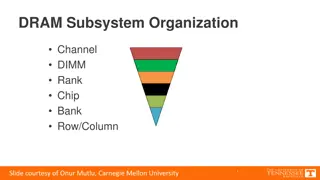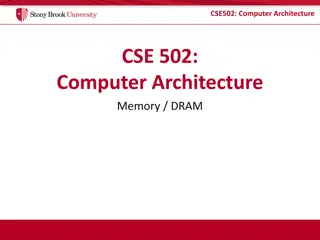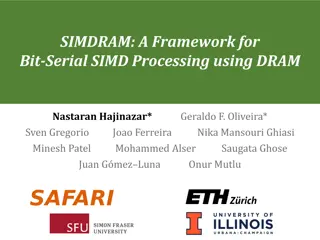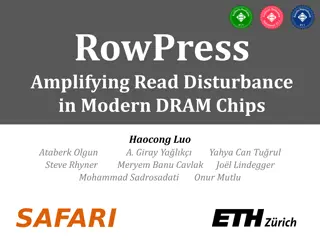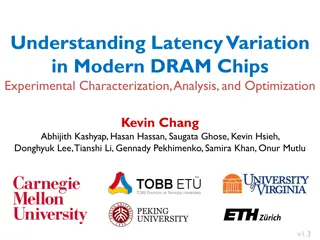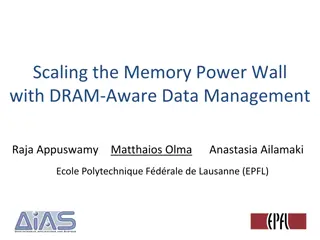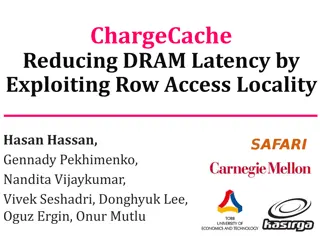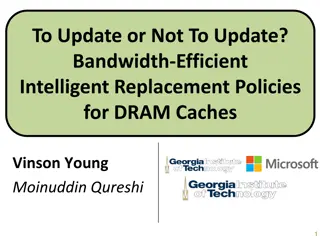Panopticon: Complete In-DRAM Rowhammer Mitigation
Despite extensive research, DRAM remains vulnerable to Rowhammer attacks. The Panopticon project proposes a novel in-DRAM mitigation technique using counter mats within DRAM devices. This approach does not require costly changes at multiple layers and leverages existing DRAM logic for efficient mitigation. The paper also highlights various prior Rowhammer mitigation approaches and the continued challenges in securing DRAM against such attacks.
Download Presentation

Please find below an Image/Link to download the presentation.
The content on the website is provided AS IS for your information and personal use only. It may not be sold, licensed, or shared on other websites without obtaining consent from the author.If you encounter any issues during the download, it is possible that the publisher has removed the file from their server.
You are allowed to download the files provided on this website for personal or commercial use, subject to the condition that they are used lawfully. All files are the property of their respective owners.
The content on the website is provided AS IS for your information and personal use only. It may not be sold, licensed, or shared on other websites without obtaining consent from the author.
E N D
Presentation Transcript
Panopticon: A Complete In-DRAM Rowhammer (RH) Mitigation https://github.com/microsoft/Panopticon Tanj Bennett*, Stefan Saroiu, Alec Wolman, and Lucian Cojocar Microsoft, *Avant-Gray LLC DRAMSec 2021 June 17th, 2021 For in-depth background on DRAM and RowHammer see https://youtu.be/duNJzNkVKbQ
Why is Rowhammer Still with Us? Nearly a decade after Rowhammer first emerged, DRAM remains as vulnerable as ever It affects all types of DRAM: DDR/LPDDR/GDDR Newer DRAM is more vulnerable to RowHammer than older DRAM Despite much research, complete mitigations are not yet deployed State-of-the-art schemes still too expensive in practice (require too much CAM/SRAM) Most mitigations require costly changes at multiple hardware/software layers
Panopticon: Complete, In-DRAM Mitigation Main idea: implement simple counter mats inside DRAM device Each row in a DRAM device has a corresponding counter When counter reaches Rowhammer threshold, perform mitigation Mechanism: open-space, staggered counter mat designs Benefits: Unlike most previous schemes, no need for large fast memories, such as CAM/SRAM Counter lookup is essentially free; use DRAM s existing row decode logic Other than to DRAM, no other changes needed for DDR4 Should work with commodity DDR4 memory controllers
Outline Introduction and motivation Prior work and its shortcomings Panopticon: high-level overview Panopticon: DRAM architecture Security analysis Conclusions
4 Prior RH Mitigation Approaches Tracking Rowhammer events, such as DRAM row activate or cache miss (BlockHammer [HPCA 21], Graphene [MICRO 20], TWiCe [ISCA 19], any many others ) Mitigation is performed whenever tracking detects an ongoing attack Sampling Rowhammer events at a fixed rate (PARA [ISCA 14], PRA [CAL 14]) Mitigation is performed proactively on each sample Partitioning memory into isolation perimeters to confine attacks (ZebRAM [OSDI 18], GuardION [DIMVA 18], Hammer Time [HotOS 21]) Clean-slate approaches: inter-cell energy barriers, deep trench isolation (Doping Profile [IEEE T-DMR 16], Physics of Insecurity [IEEE T-ED 21])
1. Tracking has Significant Cost Overhead State-of-the-art tracking aims to use fewest counters to track all rows All require costly CAM/SRAM to implement counter lookup or hashing tables For example, Graphene requires an astonishingly small state Only 2,511 bits can track entire DDR4 bank -- O(100K rows)! But this quickly adds up 1 DDR4 channel has up to 128 banks, 1 CPU up to 4 channels Per-Bank (bits) Per-Channel (KB) Per-CPU (KB) Graphene 2,511 39.23 156.9 BlockHammer 13,312 208 832 TWiCe 22,200 346.88 1,387.5
2. Tracking Require Changes at Many Layers Most prior works implementations are outside the DRAM device Either in memory controller or in RCD Performing mitigation requires DRAM device s cooperation Counters track aggressor rows, but mitigations must be done to victim rows Only DRAM device knows victim rows identity Prior works propose new DDR command: Nearby Row Refresh Memory controller reports aggressor rows to DRAM DRAM s responsibility to identify and refresh all victims
Outline Introduction and motivation Prior work and its shortcomings Panopticon: high-level overview Panopticon: DRAM architecture Security analysis Conclusions
Tracking b10 toggles from 0 to 1 b10 toggles from 1 to 0 threshold bit b10 Row # 16-bit CNT Row # 16-bit CNT Row # 16-bit CNT 0x0 0x87FF 0x0 0x87FF 0x0 0x8800 ACT 0x2 ACT 0x0 0x1 0xE806 0x1 0xE806 0x1 0xE806 0x0 0x2 0x13FF 0x2 0x1400 0x2 0x1400 0x2 0x2 0x3 Counter Table 0x82EE 0x3 Counter Table 0x82EE 0x3 Counter Table 0x82EE Service Q. Service Q. Service Q. Performing Mitigation Row # 16-bit CNT Row # 16-bit CNT Service row 0x2 0x0 0x8800 0x0 0x8800 0x1 0xE806 0x1 0xE806 Refresh row 0x0 Refresh row 0x1 Refresh row 0x3 Refresh row 0x4 0x0 0x2 0x1400 0x2 0x1400 0x2 0x0 0x3 Counter Table 0x82EE 0x3 Counter Table 0x82EE Service Q. Service Q.
Challenge 1: When to Service Queue? Two possibilities: Upon receiving REF, DRAM re-purposes some of its time for servicing queue DRAM asks memory controller for additional time (pause) Unfortunately, no DRAM protocol lets DRAM ask for time (hint to JEDEC!) But, DDR4 has ALERTnsignal for DRAM to signal errors Upon receiving ALERTn, memory controller must re-issue failed command Idea: To ask for time, DRAM asserts ALERTnand ignores dup. commands
Challenge #2: Where to Implement Queue? Queue s implementation must use SRAM DRAM vendors can size their queues as small as needed, even 1 entry When queue is full, DRAM asks for time! Provides way for DRAM vendors to differentiate themselves Larger the queue, less need to ask for time (aka better perf.) But small queue is still safe
Outline Introduction and motivation Prior work and its shortcomings Panopticon: high-level overview Panopticon: DRAM architecture Security analysis Conclusions
Security Analysis: Is It Difficult to Create Undesirable Scenarios? Scenario #1: Place rows in service queue in back-to-back refresh intervals Scenario #2: Fill up the service queue Are these undesirable scenarios difficult? Answer: NO! But DRAM remains safe (when scenario occurs, Panopticon triggers ALERTn)
Conclusions Complete in-DRAM RH mitigation No changes to other hardware components Leverage ALERTnto ask for time https://github.com/microsoft/Panopticon Plan of Jeremy Bentham's panopticon prison, drawn by Willey Reveley in 1791

